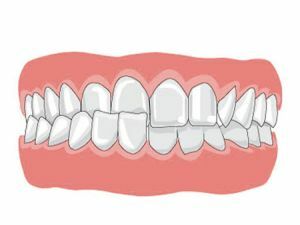 Cross bite is a dental disease, during which the lower jaw is displaced relative to the upper jaw. As a result, the dentition lines intersect.
Cross bite is a dental disease, during which the lower jaw is displaced relative to the upper jaw. As a result, the dentition lines intersect.
In medicine, this malocclusion is also called an oblique or lateral occlusion, lateroreviation, laterogenia, etc. The most severe form. It occurs rarely, but with respect to other occlusion disorders requires complex treatment.
Pathology covers 2-3% of adults and 1-1.5% of children.
The laterogenia delivers many troubles to a person in the physical and psychological aspects, which leads to the need to study the causes of the occurrence, as well as methods of treating the disorder.
Contents
- Causes of
- Causes of
- Current classification of
- Characteristic symptomatology
- Diagnostic criteria and methodologies
- Correction of pathology
- Retardation period
- Consequences and prevention
Causes of
The etiology of crossbite is most often associated with a hereditary factor or a particular habit. Also, pathology can act not as a separate disease, but be one of the symptoms of jaw osteomyelitis, hemiatrophy, ankylosis of the TMJ.In such cases, the restoration of the bite is combined with the elimination of the underlying disorder.
As a rule, the lateral occlusion is:
- congenital pathology;
- hereditary factor;
- jaw injuries;
- overly compressed jaws during sleep, resulting in injured teeth;
- decreased strength of jaw bones due to lack of calcium;
- tooth loss;
- inflammatory diseases of the throat, ears and nose;
- disturbed nasal breathing;
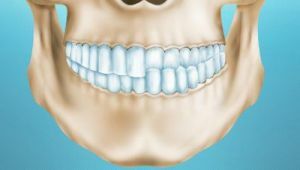
- slow growth of one of the jaws;
- cleft palate;
- the presence of bad habits in childhood: the child constantly bites his lip, sucks a finger or any object;
- abnormal growth of permanent teeth, due to untimely replacement of dairy;
- defective chewing function: flaccid chewing food or stress only one side;
- incorrect recovery mode after surgery on the jaws;
- after prosthetics when the doctor determines the ratio of jaws incorrectly.
Modern classification of
The specific structure of the maxillofacial system and the underlying causes of pathology affect the features of cross-bite manifestations. Anomaly can affect one or both sides of the jaw bones, be symmetrical or asymmetric.
Also pathologies can be exposed to the front or side of the dentition. Anomaly can touch one tooth, several or all of the lateral segment. It is very important to diagnose correctly the species of laterogeny, since the treatment scheme depends on this fact.
Orthodontists divide lateral bite into the following species:
- Buccal .It is not difficult to diagnose. As a result of impaired occlusion, swallowing and chewing functions change, food intake causes difficulties. The lower jaw can not move, an expansion of a number of teeth of the lower jaw or narrowing of a number of upper teeth from one or both sides occurs. Sometimes the jaw is shifted to the side diagonally or between the central incisors under the middle of the nose.
- Lingual .Affects one or both sides of the jaw. It happens that the lateral teeth are closed. It is manifested by the enlargement of a row of teeth in the upper row and a narrowing in the lower row.
- Buccal-lingual .The most common form and is treated with difficulty. Has the most pronounced symptoms and is not difficult to diagnose. Cross bite in this case is always combined with the displacement of the lower jaw to the side, resulting in distortion of the face.

The last type of pathology is divided into:
- dental alveolar - manifested by underdeveloped or, conversely, overly developed dental alveolar jaw arches;
- gnathic - characterized by abnormalities( abnormal constrictions or enlargements) in the development of the jaws;
- articular - displacement of the lower jaw to the right or left.
- Symptomatic
In the case of laterogeny, the symptoms are expressed as:
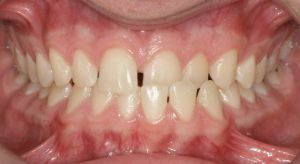
- by asymmetry and deformation of the face( the chin is shifted to the right or left, the upper lip is sagging, the lower part of the face is flattened from the opposite side when the chin is bent);
- with a jaw bias in the horizontal plane with a wide open mouth;
- uneven erasure of molars;
- painful sensations, a crunch in the jaw joints, if the mouth opens;
- by crossing the teeth of the upper and lower rows in one or two places.
Pathology also leads to functional changes:
- impaired chewing function;
- mucosa is permanently injured due to its biting;
- decreased mobility of the lower jaw;
- is broken diction;
- discomfort appears.
Diagnostic criteria and procedures
It is important to diagnose the cross-bite and form of the anomaly correctly, in time, because the treatment depends on it. Mandatory diagnostics includes:
- External inspection of .The ailment is easily determined visually by the clinical picture.
- Anamnesis collection .The patient finds out the presence of injuries, strokes and other causes that could provoke pathology. When determining the crossbite in children, it becomes clear that there are abnormalities during fetal gestation and during childbirth.
- Functional Samples .The most frequently resorted to a sample by Ilya-Markosyan, with the help of which the pathological displacement of the lower jaw is assessed. The anomaly is studied in a calm state, with a wide open mouth, during conversation, etc.
Often an additional X-ray examination is required. Namely:
- Orthopantogram of .It is prescribed to patients older than five years. It gives an opportunity to receive full information about the dentition and
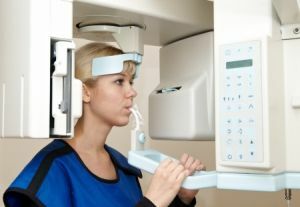 asymmetry of the jaw bones.
asymmetry of the jaw bones. - Teleradiography of the .There is an evaluation of cranial bones and an abnormal increase in the jaw, an abnormal location of the teeth.
- X-ray of the brush .Sometimes it is in demand when choosing a treatment regimen for a patient in adolescence. It allows to determine the stage of growth of the child's bones.
- X-ray of the TMJ ( temporomandibular joint).It is carried out with the mouth closed and open. It allows excluding the connection between the temporomandibular joint and the cross bite.
After the examination, the orthodontist makes a decision to send the patient to the maxillofacial surgeon, pediatrician, laura and speech therapist.
Correction of pathology
Correction of the crossbite can begin at any stage of the development of the disorder, but a favorable prognosis directly depends on timely diagnosis.
The treatment regimen is of an individual nature and depends on the type and severity of the disease, the age category of the patient and the cause of the onset.
The purpose of treatment and methods of combating pathology differ depending on the age category of patients. In childhood, slowing the development of the disorder and returning the growing bones to a normal rhythm of development is required. For this it is necessary:
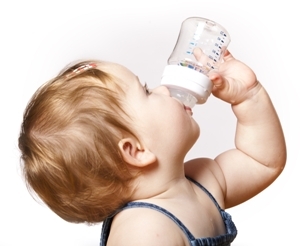
- to wean the child from certain habits( sucking nipples and fingers, putting a handle under the cheek during sleep);
- to follow that when chewing was a uniform load on both sides of the jaws;
- to prevent diseases of the nose, mouth and throat;
- give the milk teeth a flat surface, if lateral movements of the jaw are difficult;
- to engage in special gymnastics;
A sudden cross-bite often requires surgical intervention. From 5-6 years, removable plate devices are assigned, having an expanding screw and sectoral cutting.
With the help of a screw, the pathologically altered part of the dentition is enlarged. Muscles of the jaws are arranged in order with the use of buccal and labial pelots. In the same way, soft tissues are moved away from the teeth, to prevent unwanted pressure.
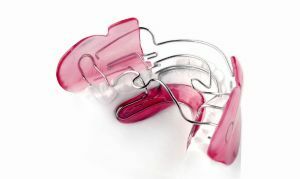
Frenkel regulator
Specialists resort to the use of the Frenkel regulator, the Andresen-Goio activator, the Persin activator, the Biderman apparatus, and other structures.
When the shooting equipment does not bring a positive result when the child reaches 10-12 years old, wireframes manufactured individually for the size of the jaw are used. The device is attached by means of orthodontic rings. Correction of the device is performed by a doctor.
In the treatment of crossbite in adults, the size of the jaw is adjusted and the deformations are evened. The patient usually wears a bracket system or the aforementioned wireframe scales. If the dentition is narrowed, it is possible to remove one or more teeth.
Minor deformities are corrected with the help of dental plates. Significant pathologies include the use outside the mouth systems - the head cap, which has a chin rest and rubber traction.
When the cross bite is difficult to correct with the usual methods, specialists resort to mechanical orthopedic adaptations - the Engle apparatus and the Katz crown.
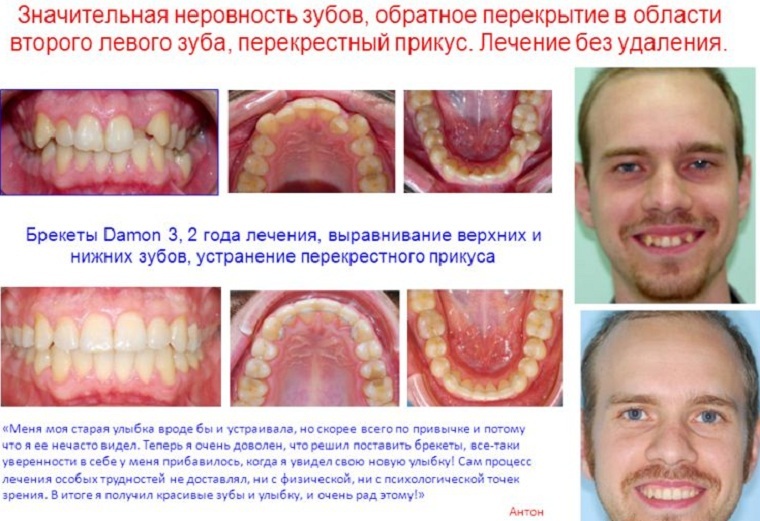
Case history and photo of patient diagnosed with cross-bite before and after treatment
Surgery is recommended for congenital or severe laterohenia and trauma.
Retardation period
After treatment of the lateral occlusion, there is a need to consolidate the result. In some cases, a natural
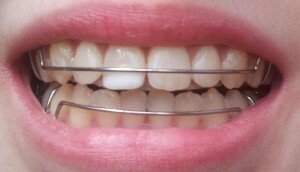 retention occurs and no special devices are required.
retention occurs and no special devices are required. Sometimes a patient needs to wear a kappa or a retainer or a removable plate from six months to three years.
Each retention machine must be: convenient, removable, invisible and stable.
In addition, you need to be constantly under the supervision of a doctor.
Consequences and prevention of
Treatment of pathology is necessary to prevent:
- malignant lesions in the mouth as a result of permanent trauma to the inner side of the cheeks and lips with teeth;
- teeth abrasion due to increased stress on them;
- visible facial asymmetry;
- pain in the area of the TMJ;
- obstructed jaw mobility;
- headaches;
- diseases of the LCM, which leads to impaired masticatory function;
- mental problems associated with a non-esthetic appearance of the face.
To avoid pathology, it is necessary to fight with provoking habits from a child's age and regularly visit a dentist in order to prevent any disease of the oral cavity or to start its treatment in time.
